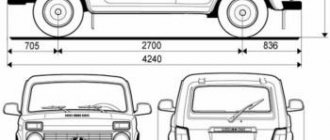The popularity of gas equipment is growing every day. This is not surprising, because the cost of such fuel (it can be propane-butane or methane) is half that of gasoline. By investing in the installation once, you can get real savings. Typically, such an installation pays for itself in a year and a half. But the trouble is that such cars do not come with LPG from the factory. We have to look for craftsmen on the side. But AvtoVAZ took a different path. In 2022, the model range was replenished with a new Lada Vesta CNG car. Reviews of owners, photos, features of this car and characteristics, see our article.
Description
The abbreviation CNG stands for compressed natural gas. The Lada Vesta of this modification is a dual-fuel sedan of the compact category, capable of running on both gasoline and gas.
This version of the Lada was developed specifically for companies involved in private transportation. This “Vesta” will be an excellent choice for taxi drivers, we are confident in the management of AvtoVAZ. By the way, this version was first presented back in 2015, a year after the debut of Vesta. But Lada Vesta CNG was launched into mass production only two years later.
Registration in order - received by OTTS
The car has passed all the necessary test drives and received vehicle type approval (VTA). The methane sedan is recognized as safe for use in everyday conditions. VAZ factory crash tests showed the reliability and safety of all connections. When testing for a frontal, side or rear impact, the seal of the cylinder was not compromised.
Appearance
The design of the gas modification is practically no different from its counterpart. The only exception is the corresponding inscription on the side of the car. Otherwise, the lines and features of the body remain the same. If we talk about the design as a whole, the Lada Vesta CNG looks very modern. Particularly worth noting are the crystal optics and the massive radiator grille, made in the X-style. As car owners note in reviews, the Lada Vesta CNG looks no worse than its foreign competitors Hyundai Solaris, Kia Rio and Volkswagen Polo. In some moments, Lada even surpasses them.
As for the quality of painting, the car does not develop chips over time. The varnish does not fade and corrosion does not appear on the arches. As stated, it was processed by hot-dip galvanizing. Therefore, the body warranty is six years.
Other reviews
Against the background of the constant appearance of new cars on the world market, the Lada Vesta of the 2015 model year is not such a new product. However, it can still be considered the discovery of the Russian car market thanks to its very modern appearance and well-thought-out technical “stuffing”. The sedan's exterior was designed by ex-Mercedes-Benz and Volvo designer Steve Mattin, and was among the first people lucky enough to sit in it.
The raised cross-country hatchback Lada Xray, which AvtoVAZ dubbed a crossover for advertising purposes, is called by many the highest quality model of the domestic manufacturer, and there is indeed reason for this. Firstly, there is an abundance of high quality imported parts, and secondly, this car has decent ground clearance and a proprietary 1.8-liter engine.
5- and 7-seater Lada Largus station wagons appeared on the Russian market in 2012, becoming a kind of continuation of the cheapest Renault Logan model, only under the auspices of a domestic manufacturer. As you might guess, the Logan-like Largus turned out to be the first Lada car built on the basis of the budget B0 platform, on the basis of which a number of Lada, Renault and Nissan models were designed.
If the image doesn’t bother you, you like the ground clearance, like a jeep, and in addition, you’ll admire the large capacity in the form of a 5/7-seater interior and a huge trunk, and “not expensive” - that’s all, we’ve arrived. Yes, not on anything, but on a raised Lada Largus with a talking Cross prefix and, of course, DNA from Renault Logan. This model, first presented to Russians in 2015, has no competitors.
The domestic auto industry never ceases to amaze. For example: when the Russian press first said that AvtoVAZ was preparing a “sports” version of the second Lada Kalina in a hatchback body, it was more difficult to get a new product for a test drive than another Bentley or Mercedes. Amazing, right? For VAZ people there is nothing special about this: not many significant new products are released after all.
What is a 3- or 5-door Lada 4×4 with the Urban prefix? Some kind of supernova Niva? In relation to an off-road passenger car from the glorious city of Togliatti, these words smack of piercing irony. New, of course - it’s been around for almost 40 years, of which 10 years the model has not been called Niva. But somehow I can’t seem to forget about my “maiden name”... So, what does “urban” promise?
It will not be a revelation to anyone that AvtoVAZ literally slept through the SUV boom. And one day they decided to somehow make up for this matter and in the summer of 2014 they presented to the general public the all-terrain all-terrain station wagon Lada Kalina Cross, built on the basis of Kalina 2. In order to become a “Cross”, the model had to survive not only external, but also internal, technical.
Dimensions, ground clearance
Judging by its dimensions, the car belongs to class B+. So, the length of the car is 4.41 meters, width 1.76, height 1.5 meters. According to reviews from owners, the Lada Vesta CNG has good ground clearance. On standard cast wheels its size is 17 and a half centimeters. This is enough for driving both on dirt roads and on snowy streets. As for the curb weight, it is slightly greater than that of the standard Vesta and amounts to 1380 kilograms. The reason for this was the weight of the gas cylinder installation itself (a huge part of it is pulled by the tank).
Dimensions
| № | Positive |
| 1. | Gennady (otzovik.com): the model’s dimensions are standard: 4410 / 1764 / 1497, wheelbase width 2635, as in previous modifications. |
| 2. | Vladimir (https://zr.ru): in dense city traffic it is sometimes difficult to change lanes, but I have already adapted. |
| 3. | Sergey (autobann.su): the dimensions of the car are average, a typical class “B” car. |
| 4. | Vladimir (lada-vesta.net): Vesta is no wider than Grants or Priors, so it won’t be difficult to handle on the highway. |
| 5. | Dmitry (otzovik.com): the car is just right for driving through city traffic jams, compact, economical, ergonomic. |
| 6. | Semyon (https://zr.ru): I use LadaVesta myself and recommend it to others. |
| 7. | Mark (autobann.su): for a small family of four - just right. |
| 8. | Georgy (lada-vesta.net): I bought a LadaVesta two years ago, I’m still happy with it, I don’t regret it. |
| 9. | Stepan (otzovik.com): compactness was one of the main factors for me when purchasing the LadaVesta. |
| 10. | Vladimir (https://zr.ru): a decent budget domestic car. |
| 11. | Alexander (autobann.su): my recommendations for car enthusiasts, the model is good, practical, small in size. |
| 12. | Mikhalych (https://forumvesta.ru): a gas installation combined with a small size is just right for urban use. |
| 13. | Vitaly (lada-vesta.net): after a year and a half of operation, the opinion is positive, there were no major breakdowns. |
| Negative | |
| 14. | Konstantin (https://zr.ru): externally the car is huge, but there is not enough space in the cabin. The parking lot is difficult to maneuver. |
| 15. | Vitaly (otzovik.com): the sloping rear window limits the visibility area, making it extremely difficult to back up. |
| 16. | Grigory (autobann.su): In Grant, visibility was better implemented. |
Related link:
Lada Vesta SV and Lada Vesta SV Cross. What is the fundamental difference and which is better to choose?
Salon
The interior design is very nice, car owners say in reviews. "Lada Vesta CNG" has no similarities with the "Kalinovsky" or "Priorovsky" salon. Its design was developed from scratch. The center console, equipped with a large multimedia screen, looks nice. The instrument panel is designed in a sporty style. Each scale is in a separate well.
The steering wheel is three-spoke, with a pleasant grip. The Lada Vesta CNG has a very spacious glove compartment. Reviews say that the car has well-thought-out ergonomics. Thanks to the comfortable seating position and location of the controls, the driver does not get tired behind the wheel. This is especially important for taxi drivers, for whom the driver's seat is their workplace. But there are no additional gadgets in the interior of the gas Vesta. The only small thing that is convenient and necessary is the fuel level sensor in the gas cylinder. As noted in reviews, this is very convenient - you can always control how much gas is left in the car. After all, such sensors are usually not installed in third-party workshops.
↑ How and where to fill a car with gas
As we said above, there are not many gas stations capable of providing the Lada Vesta with methane. There are no more than 300 such places throughout the country. But this is not so bad when compared with 2016, when there were only 30 such stations in the country. According to plans, 25 more places will be built in the country this year where it will be possible to refuel with methane.
A car with gas equipment is of particular interest to residents of the southern and Caucasian regions. It is in this direction that most new stations are being built. The popularity of cars largely depends on the development of this direction.
In order to refuel the dual-fuel version, an adapter is issued at a special station, which snaps onto the fitting under the hatch. Next, you need to attach the other end to the column and perform refueling.
Special mobile stations with gas fuel can partially correct the situation. PAGZ is a semi-trailer with 16 cylinders holding 5 thousand cubic meters of gas. This is enough to power 100 GAZelle cars and 250 VESTA passenger cars using methane.
{banner_banner1}
These mobile fuel stations are reliable and provide fast refueling. At the same time, they can be quickly refueled at points where propane and methane are available. Thanks to this, they always have gas in them. Today they are not widely used. You can meet in Stavropol. In the near future it will appear between Moscow and St. Petersburg.
Trunk
The trunk volume of the gas Vesta is small - only 250 liters. Why is this volume almost half that of the gasoline model? It's simple - there is a gas cylinder in the trunk. It is he who hides so much free space. It is located behind the back of the rear seats.
As drivers note in reviews, Vesta CNG has an unfortunate cylinder location. Because of this, it is not possible to transport long loads. Although the seat backs can still be folded. By the way, the volume of the cylinder itself is 90 liters.
Comparison of Lada Vesta CNG 2023 with Renault Logan and Kia Rio
| Comparison parameter | CNG Classic | Renault Logan Access | KIA Rio Classic |
| Engines | |||
| Minimum price in rubles | 609 000 | 499 000 | 699 000 |
| Base motor power (hp) | 106 | 82 | 100 |
| At rpm | 5800 | 5000 | 6000 |
| Maximum torque in Nm | 148 | 134 | 135 |
| Maximum speed in km/h | 172 | 172 | 185 |
| Acceleration 0 – 100 km/h in seconds | 12,6 | 11.9 | 12.2 |
| Fuel consumption (highway/average/city) | 5,5/9,3/6,9 | 9.8/5.8/7.2 | 7.2/4.8/5.7 |
| Number of cylinders | 4 | 4 | 4 |
| engine's type | Petrol | ||
| Working volume in l. | 1,6 | 1,6 | 1,4 |
| Fuel | AI-92/95/methane | AI-92/95 | AI-95 |
| Fuel tank capacity | 55 l/90 l cylinder | 50 l | 55 l |
| Transmission | |||
| Drive unit | Front | ||
| Transmission | Manual transmission | ||
| Number of gears | 5 | 5 | 6 |
| Chassis | |||
| Availability of alloy wheels | — | — | — |
| Tires | R15 | R15 | R15 |
| Body | |||
| Number of doors | 5 | 5 | 5 |
| Body types | Sedan | ||
| Curb weight in kg | 1150 | 1106 | 1080 |
| Permitted weight (kg) | 1580 | 1545 | 1530 |
| Dimensional | dimensions | ||
| Length (mm) | 4410 | 4346 | 4410 |
| Width (mm) | 1764 | 1732 | 1730 |
| Height (mm) | 1497 | 1517 | 1470 |
| Wheelbase (mm) | 2635 | 2634 | 2600 |
| Ground clearance/clearance (mm) | 178 | 160 | 160 |
| Salon | |||
| Trunk volume | 390 | 510 | 480 |
| Options | |||
| ABS | + | + | + |
| On-board computer | + | — | + |
| central locking | + | — | + |
| Rear electric windows | — | — | — |
| Airbags (pcs.) | 1 | 1 | 2 |
| Air conditioner | — | — | + |
| Heated mirrors | — | — | + |
| Front electric windows | + | + | + |
| Heated seats | — | — | — |
| Fog lights | — | — | — |
| Steering wheel adjustment | + | + | + |
| Seat adjustment | — | + | + |
| Stabilization system | — | — | + |
| Audio system | — | — | — |
| Metallic color | 12,000 rub. | 14990 rub. | + |
Specifications
You shouldn't expect much variety in the engine lineup. The gas "Vesta" is equipped with a single 1.6-liter engine. It was a VAZ engine with index 21129. This is a four-cylinder unit with a 16-valve timing mechanism. Maximum engine power is 106 horsepower and torque is 148 Nm.
But, as drivers note in reviews, the Lada Vesta CNG on gas produces slightly different characteristics. The above parameters can only be achieved when using 95 gasoline. If we talk about driving on natural gas, the power will drop by about 5%. The same goes for torque. Therefore, the dynamic characteristics of the gas-powered Vesta are far from top-notch. So, acceleration to hundreds takes 12.9 seconds. And the maximum speed is 170 kilometers per hour. If the same engine runs on gasoline, acceleration to hundreds will be reduced by 1.1 seconds. And the maximum speed will increase to 177 kilometers per hour.
Riding on methane
Compared to gasoline, this car does not run on methane at all. According to the factory specifications, from 106 liters. With. 90 remains, the car really doesn’t move. Very poor acceleration and traction. After switching to gasoline, a vigorous thrust is felt.
I scoured the Internet and realized that people turn to chip tuning specialists. I found these guys who promised to reflash the electronic unit and install dual-mode firmware. One for gasoline, the other for gas. As I understand it, they want to turn off the catalyst and flash it for Euro-2. The gas settings will also be made different, they will install a hidden relay that will switch from one mode to another.
We'll see what happens, but at the moment the car is a complete vegetable.
Factory firmware
For the sake of the environment, Euro-5 firmware was installed, the car drives poorly. If you want to accelerate sharply, then after 3700 rpm gasoline is injected. Then the acceleration begins.
About consumption
In the combined cycle, this car consumes 6.3 cubic meters of gas per 100 kilometers. Refueling is carried out through the same hatch (but it has a separate hole for gas).
The power reserve is approximately 285 kilometers. A 90-liter tank can hold up to 18 cubic meters of gas. Considering that the price of this fuel is much lower than that of gasoline, such an installation pays for itself after about a year of regular use. By the way, on gasoline this engine spends about seven and a half liters per hundred in the same mode.
Prejudices of opponents of HBO
They usually relate to 2 points:
You should not believe theories that the presence of a gas cylinder on board Vesta increases the risk of an explosion. Cylinders, made of almost 4 mm steel, and also equipped with safety valves and other shut-off valves, are much more durable than gas tanks and can withstand very strong impacts in an accident. Moreover, even a break in the fuel lines will not cause detonation. In addition, the ignition temperature of the gas-air mixture of propane is higher than that of gasoline vapor, and the mixture itself is heavier than air.
The strength of HBO cylinders meets the highest standards. They are much stronger than the standard Vesta gas tank.
But there is also an opinion that installing gas equipment will over time negatively affect the condition of Vesta’s fuel system, even to the point of replacing the fuel pump. However, this happens to those drivers who begin to save excessively. After all, the Lada’s power unit starts up on gasoline. Therefore, it is necessary to prevent the gas tank from being completely empty, as this leads to accelerated wear of the gas pump.
With a constant minimum level or absence of gasoline, the Vesta fuel pump wears out faster.
Resource
Is a gas unit really that reliable and how long will such an installation last? According to expert reviews, Lada Vesta CNG has the same engine life as its gasoline modification. If you do not adjust the technical part and settings of the gas reducer, such an engine will last even longer than a gasoline engine. After all, natural gas burns cleaner, without forming soot and deposits. The candles are always clean, without deposits. And even in winter, this system works without problems (unlike propane-butane, the gearbox of which needs to be warmed up in winter).
The fuel rail and gearbox in the Lada CNG are maintenance-free. Their service life is about 15 years. The cylinder lasts the same amount of time. But the gas line filter needs to be changed after 25 thousand kilometers.
Second meal
Switching is done by pressing one button - after upgrading the car, the corresponding equipment will appear on the working panel: a switch and an indicator of the alternative fuel consumption sensor. The controller of modern gas equipment for injection engines has the function of additional injection of gasoline at high speeds and automatic transfer when the cylinder is insufficiently filled.
Methane equipment has always been negatively associated with increased cost - this is due to the need to use high-tech monitoring and control equipment and thicker-walled storage tanks. However, the demand for methane and the corresponding infrastructure (gas stations, specialized car services, spare parts and consumables stores) is steadily growing every year. After 40 thousand kilometers (average data), the costs of gas equipment components are compensated; all further kilometers bring the desired and tangible savings on fuel.
About the disadvantages
Are there any disadvantages to the Lada Vesta CNG? Reviews say that during operation there are difficulties in finding a gas station. If there are propane gas stations at every step, then you need to look for methane gas stations. Moreover, they do not exist in every city. The reason for this is the non-transportability of this fuel. Also, gas stations are most often built on a pipe. That's why there are so few of them. Very small range of the car on gas. Considering that the car will work in a taxi, the driver will have to refuel it every day, if not more often.
The next minus is the cylinder itself. Its weight is about one hundred kilograms. But this is not the main disadvantage of the Lada Vesta CNG. This tank is located behind the seats, which significantly reduces trunk volume. There is no point in transforming the seats.
We also note that the cost of the gas version is from 630 thousand rubles. This is 60 thousand rubles more expensive than the same petrol Lada Vesta.
Why did I buy Vesta on methane?
To save on fuel. I found out from a friend that his consumption was only 80 kopecks per kilometer. This is at the time of 2022, when gas cost 12-13 rubles per cubic meter. I was very surprised, is it really such a savings? Now my consumption in the city is 1.70 rubles per kilometer.
If you drive carefully on the highway, the consumption will be 1.10 rubles. per km. If I start to “drown”, then the consumption increases. There is additional injection for gasoline. I hope for new firmware, which should bring real savings.
Refill adapter
Vesta is equipped with gas equipment of the European standard using the NGV1 connector, while in Russia most gas stations have GOST filling fingers installed. Therefore, to refuel with methane you will need a special adapter, which in most cases is called the “NGV1 TO GOST” adapter. You can buy it in various popular online stores, or look for it in stock in your city. The price for it varies greatly - from 4,000 rubles. up to 20,000 rubles, depending on the manufacturer.
The adapter for Vesta itself looks like this:











